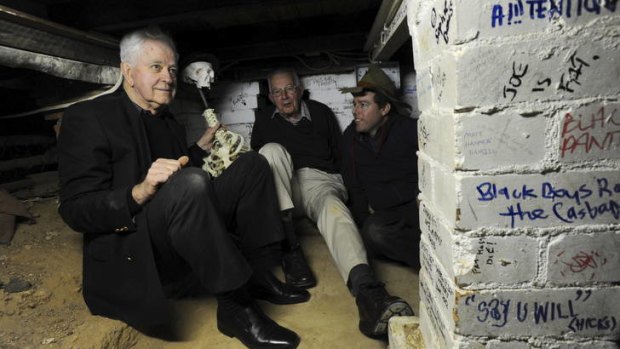
At RMC Duntroon, former officer cadets Ross Thomas and Peter Anderson reminisce on the good old times, in their ‘room within a room’.Credit: Graham Tidy
Cautiously, step by step, I creep down the small white ladder that leads from a trapdoor hidden beneath a bed in room 92 at Duntroon’s Cork Block. After just five rungs I reach the bottom.
‘‘Watch your head’’ comes the muffled cry above from Ross Thomas. It might be 54 years since Thomas made regular sorties into this hole, but he hasn’t forgotten the head-bruising obstacles. I duck just in time and avoid a crossbeam.
There’s less than a metre of height between the dust-covered concrete floor and the creaking floorboards now above my head. I need to make room for Thomas and his 1958 Duntroon classmate Peter Anderson, so I half-crouch and half-crawl crab-like across the floor to the far end of the hole.
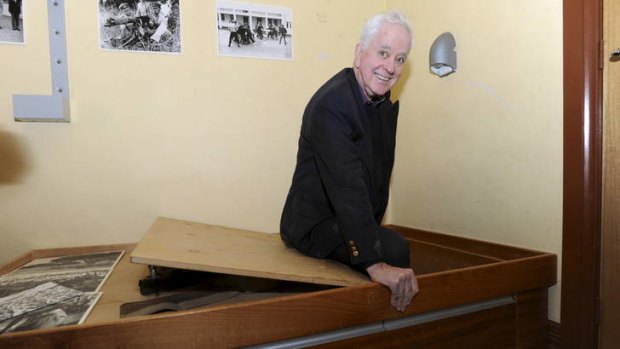
Ross emerges from 'the hole'.Credit: Graham Tidy
Pulling cobwebs from their distinguished crops of snow-white hair, and wiping dust from their beaming eyes, Thomas and Anderson soon join me. Well actually, there’s four of us in total if you count the fake skeleton that’s slumped in the corner.
So what has led your Akubra-clad columnist to this covert rendezvous with two 70-plus-year-olds in a secret bunker beneath the Royal Military College of Australia? Well, it all dates back to a column a few months ago (‘‘Wonders of Duntroon’’, October 22, 2011) in which I asked for any information on Duntroon’s fabled ‘‘room within a room’’ or as some call it ‘‘Cork Block cavern’’. Both Thomas and Anderson wrote to me and not only confirmed the bunker’s existence, but also wanted to set the record straight on its purpose because ‘‘the complete story of our escapade has never been told’’. Earlier this week Duntroon granted us access to the usually secure off-limits bunker.
As we flick the light switch on and the pall of dust caused by our jostling in the cramped space begins to settle, both men reflect on the last time they were here together –more than 50 years ago.
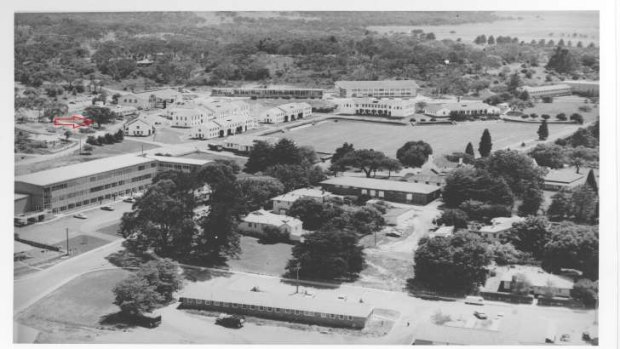
An aerial taken in 1961 of Duntroon. The red arrow points to the large gum tree behind the Cork Block where dirt from the 'hole' was initially dumped by cadetsCredit: RMC Archives
‘‘It is pretty much as I remember it,’’ says Thomas, whose room was above it when he was a third-class cadet in the ‘‘clink’’ 1958. ‘‘We called college the clink because it really did feel like jail for many of us; discipline was tough and leave was restricted to Saturday night and all day Sunday, that’s if you were lucky enough to have the funds to leave the college.’’
‘‘To me it seems smaller,’’ says Anderson, who was one of a dozen or so of Thomas’s classmates who assisted in the construction of the ‘‘hole’’.
So what prompted 19-year-old Thomas to hack a covert bunker beneath his room? Was it to hide alcohol, or a place to meet a girlfriend – both of which were forbidden on campus? Well, it turns out it was neither. ‘‘It was much more mundane – it was the need to find somewhere to keep dirty equipment like muddy sports shoes away from the prying eyes of regular inspections by superiors,’’ reveals Thomas.
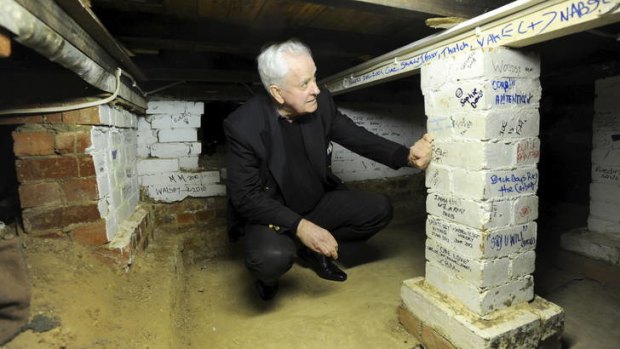
73-year-old Ross Thomas of Chapman, inspects markings on the wall.Credit: Graham Tidy
‘‘Back then we all had a place for everything – there were cupboards and spaces in every cadet’s room numbered one to 12 where all your official belongings had to be neatly displayed. For example, hanging space in your wardrobe was number one and shelving for shirts and underclothes were to be neatly folded in number 2 and number 3 and so on – everything was to be immaculately folded and, of course, in pristine condition. But what about dirty sandshoes and muddy football boots? There was no place to store them nor the unauthorised accumulation of junk that one manages to acquire at that age. And so cadets invented secret places – or number 13s – like in in the roof.’’
One Saturday afternoon in April 1958, for some reason Thomas didn’t go to compulsory sport and while resting in his room he heard a ‘‘thump, thump, thump’’ coming from the room of his mate Warwick Hamilton. ‘‘I went to investigate and discovered that not only had Warwick also shirked the afternoon’s activities, but he was busy nailing a false back to his wardrobe in order to create a number 13,’’ Thomas says.
‘‘I thought I need to do something similar so put my mind to work and came up with the idea of the trapdoor under the bed. Warwick then heard all the banging in my room and came over to check it out, and over coming weeks, one thing led to another and after showing our inner circle of mates my subterranean 13 we all agreed it would be a bit of a challenge to make it bigger and to create somewhat of a retreat.
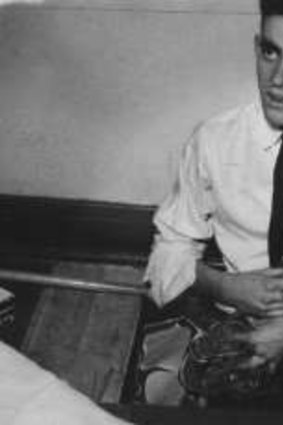
Ross Thomas emerges from the 'hole' circa mid-1958.Credit: With thanks to Ross Thomas and RMC Archives
‘‘When the trapdoor was inserted in the corner of the room under the bed, there was only about 15 inches of space under the floorboards – barely enough room for one person to squeeze into so we set to work with our bayonets and entrenching tools (a small spade) to dig out a bigger space.’’
And so began the great excavation of Cork Block cavern. Whenever Thomas and his mates had a spare moment (either in study period, Sunday afternoons or during lights out) between May and August 1958, they would furiously, Great Escape-style, dig away at the ever-expanding hole.
Thomas’s merry gang of workers would take turns in filling their kitbags with dirt, haul them up through the trap door then drag them through his room, out the window and across the verandah to where they’d be emptied beneath a gum tree. ‘‘Hundreds of kitbags of soil were brought up – I remember 40 kitbags brought up on one particularly industrious Sunday afternoon,’’ recalls Thomas. ‘‘It must have been good topsoil, for the gum tree is still alive and looking very healthy. How we weren’t discovered, especially during the construction phase, I really don’t know.’’
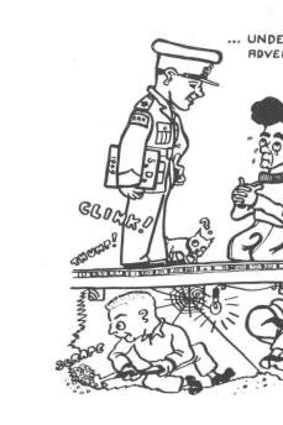
Cartoon of the digging of the 'hole' as featured in the 1960 RMC Journal (sketched by Mick Hawkins)Credit: RMC Archives
Moreover, it was risky business. ‘‘If staff had found out, all hell would have broken loose and even if our senior class found out we probably would have been charged and turfed out.’’
Despite the constant risk of being caught, once the dimensions of the room reach the desired three metres by three metres, Thomas and his mates didn’t stop there. They then set to work to decorate it, and make it more homely. ‘‘First Warwick installed a switchboard so we could have electricity in the room,’’ Thomas says. ‘‘He also installed a small switch hidden under my desk, so if there were a few lads gathered below and our company commander entered the block, I could switch the lights off and everyone beneath knew to keep still and be silent. We had one or two close shaves.’’
Then there were curtains ‘‘borrowed’’ from the Officer’s Mess at nearby Fairbairn and the concrete which Anderson admits was ‘‘borrowed from a nearby magazine artillery’’ to complete the floor. Two brick pillars were also removed to make it more spacious and further refinements included a stove for hot food and a cabinet with ‘‘borrowed crockery and cutlery’’. ‘‘All in all it was fairly cosy and about 15 people could comfortably squat on the cushions which we’d acquired.’’
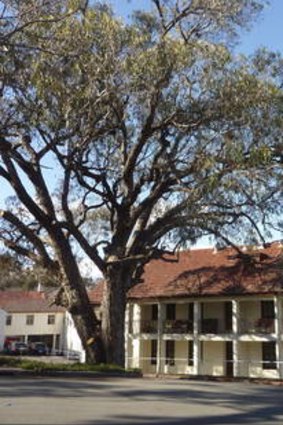
Duntroon's Cork Block and the gum tree under which much of the dirt from the excavation of the secret room was dumped.Credit: Tim the Yowie Man
Despite the extraordinary effort to construct and deck-out the mother of all number 13s, in September 1958, only a month after its completion, Thomas unfortunately had a lengthy stay in hospital and soon after his return it was Christmas leave. ‘‘So we only ended up using it a small number of times,’’ Thomas laments.
In 1959, as was the custom, Thomas and his mates were all assigned to different companies ‘‘I was assigned to a company in the new blocks and had to shift rooms accordingly,’’ says Thomas, who still kept ‘‘extraneous gear’’ in the hole. One afternoon after work in early 1959, he went back to Cork Block to retrieve something from the hole that day another cadet had some money stolen from his room. ‘‘The police were called and I was questioned – they wanted to know why I was in the block given my room wasn’t there anymore. Not wanting to wrongly be accused with a stealing charge I had to tell the truth, so I spilled the beans about the secret room.’’
Thomas remembers the moment he revealed the hole’s existence as if it was yesterday. ‘‘The adjutants exact words were, ‘I hope for your sake lad there is a hole when I go in there tomorrow’. I thought to myself, you aren’t going to be disappointed,’’ chuckles Thomas, who also recalls an off-campus cop asking, ‘‘Is this hole big enough you could put your hand in and place a few notes?’’, to which he replied, ‘‘You won’t be disappointed either!’’
Thomas’s superiors never acknowledged the ‘‘discovery’’ of Cork Block cavern and, equally as perplexing, he and his accomplices received none of the repercussions or punishments they were expecting. ‘‘I’m not sure if it was quiet admiration of what we’d achieved or because they couldn’t find any Standing Orders titled ‘construction of an extra room’ with which they could point to, but we were let off, scot-free,’’ says Thomas.
‘‘Nothing was ever said to us officially then nor to this day. I’m not sure they know what to do,’’ says Anderson, who reflects fondly on the hole, ‘‘It was all a bit of a challenge and definitely added to the sense of camaraderie in our group.’’
However, with the room’s cover blown, its days as a No.13 were over. ‘‘The garrison engineer ordered the removal of the electrics and that the pillars be replaced, and the room promptly closed,’’ Thomas says. Thankfully, however, the hole wasn’t filled in and it stands as a monument to an innocent era over half a century ago when cadets made their own fun.
Sign up for the Traveller newsletter
The latest travel news, tips and inspiration delivered to your inbox. Sign up now.